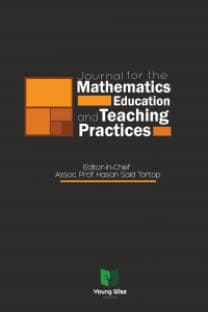A Folding Back Analysis on Elementary Students' Growth in Mathematical Understanding
The purpose of this study is to analyze folding back characteristics on elementary students' growth in mathematical understanding with relational and instrumental understanding. This research used a qualitative approach with case study. The growth in mathematical understanding is analyzed in layers of Pirie-Kieren model, namely primitive knowing, image making, image having, property noticing, formalizing, observing, structuring, and inventizing. The results of this study are folding back on students with relational understanding, from property noticing stage to image making stage. In addition, there was also a folding back from image making stage to primitive knowing stage. Folding back that occurs in students with relational understanding has a trajectory to observing stage. In students with instrumental understanding, there is a folding back from property noticing stage to image making stage, and has a path to formalizing stage. The conclusion of this research is that there is a two folding back on students with relational understanding and one folding back on students with instrumental understanding. In addition, students with relational understanding have a folding back trajectory that is longer than students with instrumental understanding.
Keywords:
Folding back, Pirie-Kieren, understanding instrumental, relational,
___
- Amin, S., Utaya, S., Bachri, S., & Susilo, S. (2020). Effect of problem-based learning on critical thinking skills and environmental attitude. Journal for the Education of Gifted Young Scientists, 8(June), 743–755.
- Bofferding, L., & Enzinger, N. W. (2017). Subtraction involving negative numbers: Connecting to whole number reasoning. The Mathematics Enthusiast, 14(1), 241–262.
- Borgen, K. (2006). From mathematics learner to mathematics teacher: Preservice teachers’ growth of understanding of teaching and learning mathematics. Unpublished doctoral dissertation, University of British Columbia: BC.
- Creswell, J. W. (2012). Educational Research, 243.
- Debrenti, E. (2015). Visual Representations In Mathematics Teaching: An Experiment With Students. Acta Didactica Napocensia, 8(1), 21–26.
- Diana, N., Suryadi, D., & Dahlan, J. A. (2020). Analysis of students ’ mathematical connection abilities in solving problem of circle material : transposition study. Journal for the Education of Gifted Young Scientists, 8(June), 829–842.
- Fatimah, A. T., & Prabawanto, S. (2020). Mathematical understanding and reasoning of vocational school students in agriculture-based mathematical tasks. Journal for the Education of Gifted Young Scientists, 8(2), 701–712. https://doi.org/10.17478/JEGYS.702884
- Greer, B. (2012). Inversion in mathematical thinking and learning. Educational Studies in Mathematics, 79(3), 429–438. https://doi.org/10.1007/s10649-011-9317-2
- Gülkılık, H., Uğurlu, H. H., & Yürük, N. (2015). Examining students’ mathematical understanding of geometric transformations using the pirie-kieren model. Kuram ve Uygulamada Egitim Bilimleri, 15(6), 1531–1548. https://doi.org/10.12738/estp.2015.6.0056
- Huberman, M. B. M. & A. M. (1994). Qualitative Data Analysis, 28.
- Indrawatiningsih, N., Purwanto, As’ari, A. R., & Sa’dijah, C. (2020). Mathematical Argumentation Ability: Error Analysis in Solving Mathematical Arguments. Journal for the Education of Gifted Young Scientists, 8(5), 711–721. https://doi.org/10.17478/jegys.654460
- Kieren, T. E. (1989). A Recursive Theory of Mathematical Understanding. For the Learning of Mathematics, 3.
- Kieren, T. E., Pirie, S. E. B., & Gordon Calvert, L. (1999). Growing minds, growing mathematical understanding: Mathematical understanding, abstraction and interaction. In L.
- Burton (Ed.), Learning mathematics. From hierarchies to networks. London: Falmer Press.
- Martin, L. C. (2008). Folding back and the dynamical growth of mathematical understanding: Elaborating the Pirie-Kieren Theory. Journal of Mathematical Behavior, 27(1), 64–85.
- Martin, L. C., LaCroix, L., & Fownes, L. (2005). Folding Back and the Growth of Mathematical Understanding in Workplace Training. ALM International Journal, 1(1), 19–35.
- Martin, L. C., & Towers, J. (2016a). Folding back, thickening and mathematical met-befores. The Journal of Mathematical Behavior, 43, 89–97.
- Martin, L. C., & Towers, J. (2016b). Folding back and growing mathematical understanding: a longitudinal study of learning. International Jounal for Lesson and Learning Studies, 5(4), 281–294.
- Orhun, N. (2013). Assessing conceptual understanding in mathematics: Using derivative function to solve connected problems. Turkish Online Journal of Distance Education, 14(3), 138–151. https://doi.org/10.17718/tojde.03120
- Powell, A. B., Francisco, J. M., & Maher, C. A. (2003). An analytical model for studying the development of learners’ mathematical ideas and reasoning using videotape data. Journal of Mathematical Behavior, 22, 405–435.
- Rahmad, B. A., Ipung, Y., Abdur, R. A., Sisworo, & Dwi, R. (2016). Mathematical representation by students in building relational understanding on concepts of area and perimeter of rectangle. Educational Research and Reviews, 11(21), 2002–2008. https://doi.org/10.5897/ERR2016.2813
- Ramadhani, R., Huda, S., & Umam, R. (2019). Problem-Based Learning , Its Usability and Critical View as Educational Learning Tools. Journal of Gifted Education and Creativity, 6(3), 219–231.
- Skemp, R. R. (2006). Relational Understanding and Instrumental Understanding. Mathematics Teaching in the Middle School, 12(2), 88–95.
- Skemp, R. R. (2013). Relational Understanding and Instrumental Understanding. National Council of Teachers of Mathematics, 26(3), 9–15.
- Syazali, M., Listiani, B., & Farid, F. (2019). Problem Based Learning (PBL) and Guided Discovery Learning (GDL) Effects of Mathematical Reasoning Capability: Analysis for Gifted Students. Journal of Gifted Education and Creativity, 6(3), 209–216.
- Towers, J. (2004). Teachers’ interventions and the growth of students’ mathematical understanding. Unpublished doctoral dissertation, University of British Columbia: BC.
- Weber, K. (2002). The role of instrumental and relational understanding in proofs about group isomorphisms. Proceedings from the 2nd International Conference for the Teaching of Mathematics, (1711553), 1–9.
- Wright, V. (2014). Frequencies as proportions: using a teaching model based on Pirie and Kieren model of mathematical understanding. Mathematics Education Research Journal, 26, 101–128.
- Yayın Aralığı: Yılda 2 Sayı
- Başlangıç: 2020
- Yayıncı: Genç Bilge Yayıncılık
